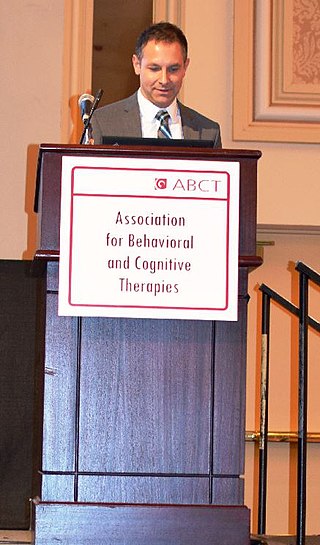Related Research Articles
Neurosis is a term mainly used today by followers of Freudian thinking to describe mental disorders caused by past anxiety, often that has been repressed. In recent history, the term has been used to refer to anxiety-related conditions more generally.
Disorder may refer to randomness, a lack of intelligible pattern, or:

Obsessive–compulsive personality disorder (OCPD) is a cluster C personality disorder marked by a spectrum of obsessions with rules, lists, schedules, and order, among other things. Symptoms are usually present by the time a person reaches adulthood, and are visible in a variety of situations. The cause of OCPD is thought to involve a combination of genetic and environmental factors, namely problems with attachment.
The Minnesota Multiphasic Personality Inventory (MMPI) is a standardized psychometric test of adult personality and psychopathology. A version for adolescents also exists, the MMPI-A, and was first published in 1992. Psychologists and other mental health professionals use various versions of the MMPI to help develop treatment plans, assist with differential diagnosis, help answer legal questions, screen job candidates during the personnel selection process, or as part of a therapeutic assessment procedure.
Perfectionism, in psychology, is a broad personality trait characterized by a person's concern with striving for flawlessness and perfection and is accompanied by critical self-evaluations and concerns regarding others' evaluations. It is best conceptualized as a multidimensional and multilayered personality characteristic, and initially some psychologists thought that there were many positive and negative aspects.
Scrupulosity is the pathological guilt and anxiety about moral issues. Although it can affect nonreligious people, it is usually related to religious beliefs. It is personally distressing, dysfunctional, and often accompanied by significant impairment in social functioning. It is typically conceptualized as a moral or religious form of obsessive–compulsive disorder (OCD). The term is derived from the Latin scrupus, a sharp stone, implying a stabbing pain on the conscience. Scrupulosity was formerly called scruples in religious contexts, but the word scruple now commonly refers to a troubling of the conscience rather than to the disorder.
In psychoanalysis, egosyntonic refers to the behaviors, values, and feelings that are in harmony with or acceptable to the needs and goals of the ego, or consistent with one's ideal self-image. Egodystonic is the opposite, referring to thoughts and behaviors that are conflicting or dissonant with the needs and goals of the ego, or further, in conflict with a person's ideal self-image.

Pierre Marie Félix Janet was a pioneering French psychologist, physician, philosopher, and psychotherapist in the field of dissociation and traumatic memory.

An intrusive thought is an unwelcome, involuntary thought, image, or unpleasant idea that may become an obsession, is upsetting or distressing, and can feel difficult to manage or eliminate. When such thoughts are associated with obsessive–compulsive disorder (OCD), Tourette syndrome (TS), depression, body dysmorphic disorder (BDD), and sometimes attention deficit hyperactivity disorder (ADHD), the thoughts may become paralyzing, anxiety-provoking, or persistent. Intrusive thoughts may also be associated with episodic memory, unwanted worries or memories from OCD, post-traumatic stress disorder (PTSD), other anxiety disorders, eating disorders, or psychosis. Intrusive thoughts, urges, and images are of inappropriate things at inappropriate times, and generally have aggressive, sexual, or blasphemous themes.
The Yale–Brown Obsessive–Compulsive Scale (Y-BOCS) is a test to rate the severity of obsessive–compulsive disorder (OCD) symptoms.
Jeffrey M. Schwartz is an American psychiatrist and researcher in the field of neuroplasticity and its application to obsessive-compulsive disorder (OCD). He is a proponent of mind–body dualism and appeared in the 2008 film Expelled: No Intelligence Allowed
Sexual obsessions are persistent and unrelenting thoughts about sexual activity. In the context of obsessive-compulsive disorder (OCD), these are extremely common, and can become extremely debilitating, making the person ashamed of the symptoms and reluctant to seek help. A preoccupation with sexual matters, however, does not only occur as a symptom of OCD, they may be enjoyable in other contexts.

Compulsive behavior is defined as performing an action persistently and repetitively. Compulsive behaviors could be an attempt to make obsessions go away. Compulsive behaviors are a need to reduce apprehension caused by internal feelings a person wants to abstain from or control. A major cause of compulsive behavior is said to be obsessive–compulsive disorder (OCD). "Compulsive behavior is when someone keeps doing the same action because they feel like they have to, even though they know these actions do not align with their goals." There are many different types of compulsive behaviors including shopping, hoarding, eating, gambling, trichotillomania and picking skin, itching, checking, counting, washing, sex, and more. Also, there are cultural examples of compulsive behavior.
Primarily obsessional obsessive–compulsive disorder, also known as purely obsessional obsessive–compulsive disorder, is a lesser-known form or manifestation of OCD. It is not a diagnosis in the DSM-5. For people with primarily obsessional OCD, there are fewer observable compulsions, compared to those commonly seen with the typical form of OCD. While ritualizing and neutralizing behaviors do take place, they are mostly cognitive in nature, involving mental avoidance and excessive rumination. Primarily obsessional OCD takes the form of intrusive thoughts often of a distressing, sexual, or violent nature.

Obsessive–compulsive disorder (OCD) is a mental and behavioral disorder in which an individual has intrusive thoughts and feels the need to perform certain routines (compulsions) repeatedly to relieve the distress caused by the obsession, to the extent where it impairs general function.
Pseudoneurotic schizophrenia is a postulated mental disorder categorized by the presence of two or more symptoms of mental illness such as anxiety, hysteria, and phobic or obsessive-compulsive neuroses. It is often acknowledged as a personality disorder. Patients generally display salient anxiety symptoms that disguise an underlying psychotic disorder.
Aboulomania is a mental disorder in which the patient displays pathological indecisiveness. The term was created in 1883 by the neurologist William Alexander Hammond, who defined it as: ‘a form of insanity characterised by an inertness, torpor, or paralysis of the will’. It is typically associated with anxiety, stress, depression, and mental anguish, severely affecting one's ability to function socially. In extreme cases, difficulties arising from the disorder can lead to suicide. Although many people are indecisive at times, it is rarely to the extent of obsession.
In psychology, relationship obsessive–compulsive disorder (ROCD) is a form of obsessive–compulsive disorder focusing on close and/or intimate relationships. Such obsessions can become extremely distressing and debilitating, having negative impacts on relationships functioning.

Jonathan Stuart Abramowitz is an American clinical psychologist and Professor in the Department of Psychology and Neuroscience at the University of North Carolina at Chapel Hill (UNC-CH). He is an expert on obsessive-compulsive disorder (OCD) and anxiety disorders whose work is highly cited. He maintains a research lab and currently serves as the Director of the UNC-CH Clinical Psychology PhD Program. Abramowitz approaches the understanding and treatment of psychological problems from a cognitive-behavioral perspective.
The Dimensional Obsessive-Compulsive Scale (DOCS) is a 20-item self-report instrument that assesses the severity of Obsessive-Compulsive Disorder (OCD) symptoms along four empirically supported theme-based dimensions: (a) contamination, (b) responsibility for harm and mistakes, (c) incompleteness/symmetry, and (d) unacceptable (taboo) thoughts. The scale was developed in 2010 by a team of experts on OCD led by Jonathan Abramowitz, PhD to improve upon existing OCD measures and advance the assessment and understanding of OCD. The DOCS contains four subscales that have been shown to have good reliability, validity, diagnostic sensitivity, and sensitivity to treatment effects in a variety of settings cross-culturally and in different languages. As such, the DOCS meets the needs of clinicians and researchers who wish to measure current OCD symptoms or assess changes in symptoms over time.
References
- ↑ American Heritage Dictionary
- ↑ Coriat, Isador H. (1911). "Psychasthenia.". Abnormal psychology. pp. 273–297. doi:10.1037/13768-014.
- ↑ Walsh, James J. (1912). "Mental incapacity (psychasthenia).". Psychotherapy: Including the History of the Use of Mental Influence, Directly and Indirectly in Healing and the Principles for the Application of Energies Derived from the Mind to the Treatment of Disease. pp. 597–603. doi:10.1037/10544-093.
- ↑ Ellenberger (1970), p. 375; Janet (1903)
- ↑ Ellenberger (1970), p. 377
- ↑ Jaspers (1963), pp.441-443